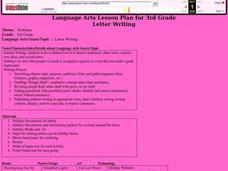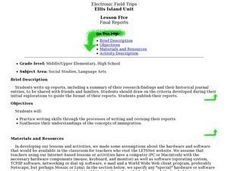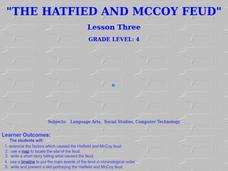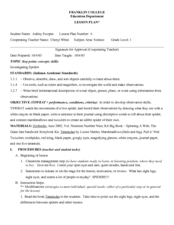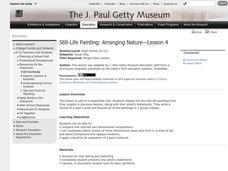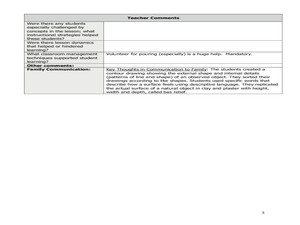Curated OER
The Learning Network: Re-envisioning Classic Stories
Readers reflect on enjoyable stories they know, brainstorm criteria that make a story "good," analyze a New York Times article about innovative children's performances, re-envision classics on their own, and peer edit drafts. Use this as...
Curated OER
Letter Writing
Third graders write to themselves or to known audiences, share news, explore new ideas, and record notes. They identify that holidays are days that people set aside to recognize a person or event that has made a great impression....
Curated OER
The BEAM Project: Building Efficient Architectural Models
Technology or engineering teams are given a task to design, construct, and test the efficiency of a structure that will foster an even temperature throughout an entire sunny day. Intended as a long-term project, pupils research, plan,...
Curated OER
Final Reports
Students write reports, including a summary of their research findings and their historical journal entries, to be shared with friends and families, and publish their reports.
Curated OER
Art Reflecting Life
Have your young television viewers discuss popular shows among their peers. After choosing one show to analyze, middle and high schoolers read about the 2007-2008 network television lineup with the New York Times article "Gauging...
Curated OER
The Hatfield and McCoy Feud
Fourth graders investigate the Hatfield and McCoy feud. For this Hatfield and McCoy feud lesson, 4th graders examine factors that caused the feud. Students also locate on a map where the feud took place, make a timeline of the main...
Curated OER
Observation Skills
First graders observe a spider and write sentences about what they see the spider doing. In this writing lesson plan, 1st graders draw what they see, then make an edible spider out of marshmallows and twizzlers. A fun, delicious lesson...
Curated OER
Lincoln's Legend and Legacy
Students evaluate Lincoln's impact on American History. In this Civil War instructional activity, students view a film clip of writings about Lincoln. Students take notes and compare how the writings define his legacy. Students write...
Curated OER
Active Voice
Students identify the qualities that contribute to effective verbal and non-verbal communication. They use those qualities as criteria by which to judge an in-class political debate on education.
Curated OER
Get Real!
Students reach a consensus as to what makes a good reality-based TV show. They create their own scenarios for a new such show, and critique it, based on the criteria the class establishes.
Curated OER
Still Life Painting: Arranging Nature
Students display the two still-life paintings they created along with their artist’s statement, write a review of a peer’s work, and discuss all of the paintings in a group critique. In this still life art lesson, students view the...
Curated OER
Shaping Ideas: Symbolism in Sculpture
Students critique the symbolic structures created by other students. In this visual arts lesson, students display completed sculptures and drawings. Students analyze the symbolic elements in each others work, relate their art to Getty's...
Curated OER
The Issues-Substance not Style
Students continue to develop criteria for evaluating candidates, consider personal qualities needed in the presidency, and compare candidate's qualifications for office. They write in their journals: "What issues get the most air time or...
Curated OER
Treasure Hunt
Students find lost "treasure" using a treasure map after being shown a map that you have created where terms and symbols are discussed. The class is divided into small groups where they locate your treasure and then read a section from...
Curated OER
Ceramics: A Vessel Into History
Students evaluate the work of their peers using the criteria for value and meaning they developed. In this ceramics lesson, students evaluate their peers’ vessels in their journals by responding to the given questions...
Curated OER
Still-Life Painting: Arranging Nature
Students display the two still-life paintings that they created in previous lessons, along with their artist's statements. They write a review of a peer's work and discuss all of the paintings in a group critique.
Curated OER
Shaping Ideas: Symbolism in Sculpture
Students participate in a class critique of the symbolic sculptures they created. They critique the work of their peers by responding to questions about the symbolic content and applying criteria for sculpture.
Curated OER
Rearrange the Room
Second graders measure and grid their ideas for the new classroom floor plan. They create their own ideas for the classroom arrangement on grid paper. When they finish, they share their draft plan with their peers and with the teacher...
Curated OER
Nest Construction and Area Management Activities
Students construct a nest for a fictitious ground-nesting bird.They create models of the bird (along with its eggs) that might theoretically live in this habitat. They write in a daily journal about what happens to their nests in a...
Curated OER
Plaster Casts of Natural Objects
Fourth graders observe objects in science and create a contour picture of the the object. In this arts and science observation lesson, 4th graders develop a clay sculpture of their object. Students generate a list of texture...
Curated OER
Match Shapes in Compositions
Third graders draw shapes that are congruent with each other and identify other congruent shapes. In this congruency lesson plan, 3rd graders also apply specific colors from the color wheel in their shapes.
Curated OER
Designing Databases
Students explore the basic concepts of a relational database by designing a questionnaire to gather information about their school's student body for use in designing more effective school programs.
Curated OER
It's Alive!
Students define the term artificial intelligence and list devises that use it. After reading an article, they discuss how advances in this field affect our lives. In groups, they brainstorm about a device that could improve the life of...
Curated OER
The Origins of American Government
Students create an advertising campaign to persuade the Founding Fathers to adopt a particular political philosophy. Working in groups, they conduct research about a certain political philosophy. Students create a pitch to be made to...



